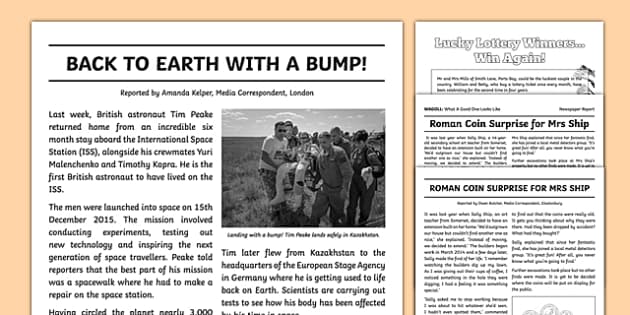The Single Strategy To Use For News Articles
The Single Strategy To Use For News Articles
Blog Article
Some Of News Articles
Table of ContentsWhat Does News Articles Do?About News ArticlesGetting The News Articles To WorkSome Known Facts About News Articles.An Unbiased View of News Articles
Excellent understanding of different subjects gives pupils an affordable side over their peers. Although digital and social media sites are easily accessible, we ought to not forget exactly how important it is to review the papers. Parents must try and instill the habit of reviewing a newspaper as a day-to-day routine to continue the heritage of the revered print tool.News stories likewise have at least one of the adhering to essential qualities relative to the desired target market: distance, importance, timeliness, human passion, oddity, or consequence.
Within these restrictions, newspaper article likewise intend to be extensive. Nonetheless, other variables are entailed, some stylistic and some acquired from the media kind. Amongst the larger and more recognized papers, justness and equilibrium is a significant variable in offering info. Discourse is generally constrained to a different section, though each paper may have a different general slant.
Papers with a global audience, for instance, have a tendency to use an extra formal design of composing. News Articles.; usual style guides consist of the and the United States Information Style Book.
What Does News Articles Do?
Generally, reporters will not utilize a long word when a short one will do. They make use of subject-verb-object building and vibrant, active prose (see Grammar). They use stories, examples and allegories, and they hardly ever depend on generalizations or abstract ideas. Information authors attempt to stay clear of using the exact same word greater than when in a paragraph (often called an "resemble" or "word mirror").
However, headlines often omit the subject (e.g., "Jumps From Boat, Catches in Wheel") or verb (e.g., "Pet cat female fortunate"). A subhead (additionally subhed, sub-headline, subheading, caption, deck or dek) can be either a subordinate title under the main heading, or the heading of a subsection of the short article. It is a heading that precedes the main text, or a group of paragraphs of the main text.

of a write-up topic, source, or interviewee), it is described as a pulled quotation or pull quote. Extra billboards of any one of these types may appear later on in the article (particularly on succeeding web pages) to tempt more analysis. Journalistic websites in some cases utilize animation methods to switch one signboard for an additional (e.g.
The Best Strategy To Use For News Articles
Such signboards are additionally utilized as tips to the post in other sections of the magazine or site, or as advertisements for the item in various other publication or websites. Press launch of the Swiss government. Normal structure with title, official site lead paragraph (recap in strong), other paragraphs (information) and call info.

Example of a hard-lead paragraph NASA is proposing an additional area job. The budget plan requests about $10 billion for the task.
An "off-lead" is the 2nd most essential front web page information of the day. To "hide the lead" is to start the post with background info or information of additional importance to the visitors, compeling them to check out more deeply into a post than they should have to in order to uncover the vital factors.
The Best Strategy To Use For News Articles
Usual use is that one or 2 sentences each develop their very own paragraph. Reporters usually describe the organization or structure of a newspaper article as an upside down pyramid. The vital and most fascinating components of a tale are placed at the start, with supporting details complying with in order of lessening importance.
It allows people pop over to this web-site to explore a topic to only the depth that their interest takes them, and without the imposition of details or subtleties that they might take into consideration irrelevant, but still making that details available to more interested readers. The upside down pyramid framework likewise allows posts to be trimmed to any arbitrary size throughout design, to fit in the space available.
Some authors start their stories with the "1-2-3 lead", yet there are lots of type of lead offered. This layout inevitably starts with a "Five Ws" opening up paragraph (as described above), followed by an indirect quote that offers to sustain a major element of the first paragraph, and then a straight quote to support the indirect quote. [] A kicker can describe several things: The last tale current broadcast; a "pleased" tale to end the show.
Longer articles, such as publication cover articles and the pieces that lead the within areas of a newspaper, are recognized as. Function tales differ from straight information in a number of means.
Unknown Facts About News Articles
The reporter typically information interactions with interview subjects, making the item more individual. A function's very first paragraphs usually relate a fascinating minute or event, as in an "unscientific lead". From the particulars of an individual or episode, its sight swiftly broadens to abstract principles regarding the story's subject. The section that signals what a function is about is called the or signboard.

The Editor's Toolbox: A Referral Guide for Beginners and Professionals (2001) Allan M. visit here Siegal and William G. Connolly. The New York City Times Manual of Design and Usage: The Authorities Style Guide Utilized by the Writers and Editors of the World's The majority of Authoritative Paper (2002) M. L. Stein, Susan Paterno, and R.
Report this page